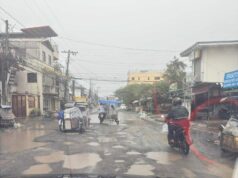This machine, called combine harvester, makes rice harvesting faster and less grains wastage. However, farm laborers call them ‘halimaw’ as they said it dislodged them from their traditional source of food and income.
PHOTO BY ELMO ROQUE
CABANATUAN CITY – Farm laborers in Nueva Ecija call them “halimaw” (beast) as they said it has gobbled their source of food and their future. “Sinalanta na po ang aming kinabukasan. Nawala na po ang inaasahan naming napagkukunan ng pagkain at kaunting kita. Paano na kami ngayon? (It wrecked our future.
Our only source of food and income is already lost. How shall we live now?),” farmers in Lupao, Nueva Ecija said echoing the same sentiments of other farmers in the province. They were referring to the combine harvesters which have taken over the traditional way of harvesting the rice crop done by human harvesters.
These machines reap the grains and spew them up already in bagged form. In Nueva Ecija, the top rice-producing province in the country, there are more than 230,000 agricultural work ers engaged in cultivating the land, planting and harvesting the crop and some other farm works.
They are the work force for palay production in the 195,000 hectares used during wet reason cropping and the 120,000 hectares for “palagad” or dry season cropping. In harvesting, the human harvesters are paid in kind. Their share is “‘ka-kinse” or one cavan for every 15 cavans they harvested.
It is their palay share which they use to secure their daily need for milled rice and for some expenses until the next harvesting season. The presence of the combine harvester was felt in Nueva Ecija in the aftermath of “Typhoon Santi” which lashed through the province while the rice crop was being harvested or about to be harvested.
It scooped, harvested and threshed the crop which the farmers refused to harvest as it was lodged in caked mud.
The harvesting machines that came to Nueva Ecija then were mostly from Isabela, now regarded as the home of hundreds of combine harvesters. “We estimated that there are now more than 200 combine harvesters in Isabela,” Glen Mandac, a progressive farmer of San Mateo town, told this reporter. “In Barangay Rizal in Alicia town alone, there are 36 combine harvesters,” he added.
In Talugtog, Nueva Ecija, Dr. Flor Amor Monta, a professor of the Central Luzon State University (CLSU) who is a native of the place, said he counted 11 combine harvesters. They were bought by the overseas workers from the place who thought that owning the machine is a wise investment.
He said he has also learned that many wellto- do Novo Ecijanos have been buying this kind of machine. Each combine harvester costs P1.6 million, it was learned. In four to six cropping seasons, the cost of the machine can be recouped by the owner, it was further learned.
But while the farm laborers lament the use of the “halimaw”, many landowners applaud it. They said harvesting and threshing time is drastically reduced. Whereas it takes a day for human harvesters to harvest a one-hectare area and about one-half day to thresh it using the mini-thresher, the machine can finish the job in three to four hours.
The fee for using the machine is lesser by one cavan than when using the human harvesters and the mini-thresher.
Grains losses are also minimized with the use of the machine, it was learned. Aside from individual owners, farmers associations, cooperatives, irrigators and local government units are also acquiring combine harvesters under the farm mechanization program of the government pursued under a counterparting agreement.
Started in 2011, the program is meant to increase the present farm mechanization level of the Philippines, from 0.57 horsepower per hectare (hp/ ha) to 0.80 hp/ha, to be at par with Thailand and Vietnam.
With a capitalization of P6 billion up to 2016, the Department of Agriculture (DA) is distributing seed cleaners, rice transplanters, power tillers with trailers, hand tractors, mini four-wheel tractors with accessories, flatbed and mechanical dryers, and combine harvesters, among others.
“This is one of the strategies that we are pursuing to increase farm productivity and reduce postharvest losses,” Agriculture Secretary Proceso Alcala said in an interview when he visited the Philippine Rice Research Institute (PhilRice) recently.
“This program will not displace farm workers as they will have more time to engage in other livelihood opportunities or additional sources of income,” he added. He urged them to form themselves into associations or cooperatives to be trained by the government to become efficient service providers or for the pursuit of other livelihood opportunities.




